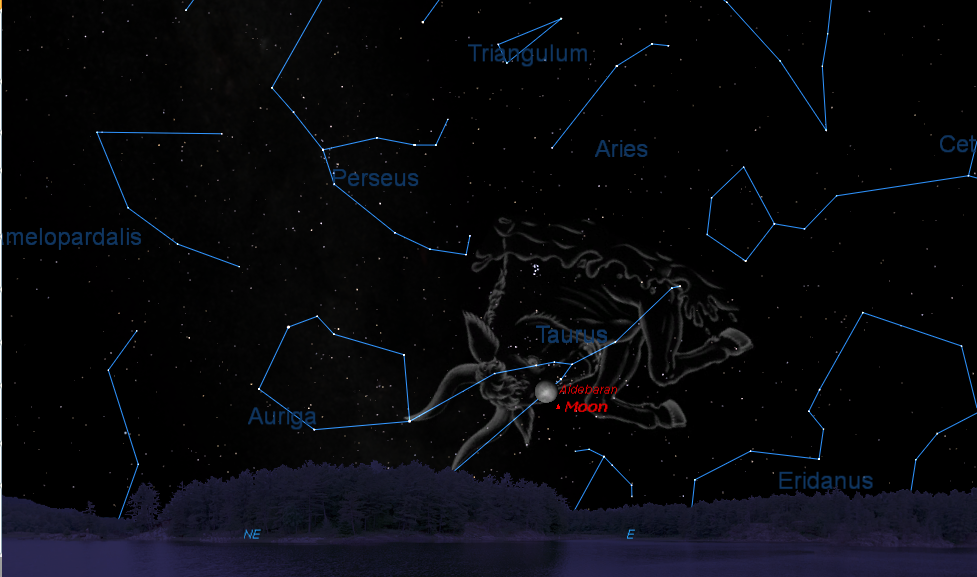Watch the Moon Hide the Orange Star Aldebaran Sunday Evening

Whenever a full, or nearly full moon is in the sky, many kinds of astronomical observation must be postponed. But a full moon this weekend brings a special treat: Across much of central and eastern North America on Sunday evening (Nov. 5), viewers can watch the moon pass in front of the bright orange star Aldebaran in the constellation of Taurus, the Bull. Of the four first-magnitude stars than can be hidden (or "occulted") by the moon, Aldebaran is the brightest.
This occultation will be visible anywhere to the east (right) of a line extending roughly from Inuvik (a town in the Northwest Territories of Canada) to Pensacola, Florida. To the west (left) of this line, viewers will not be able to see Aldebaran's disappearance, because the moon and star will be below the horizon. At those locations, either only the star's reappearance will be visible (just after moonrise) or the moon and star will be below the horizon for the entire occultation.
The moon will be one day past full and still 95 percent illuminated during the event. The farther east one is positioned, the better the circumstances will be for viewing. Along the Atlantic Seaboard, for instance the moon will rise a comfortable hour or more before the star is hidden. [Night Sky: Visible Planets, Moon Phases & Events, November 2017]
An occultation timetable
In the accompanying table, we provide a listing of 15 selected cities with local standard times, to the nearest minute, for the event. The table lists when Aldebaran will wink out behind the bright lunar limb and when the star will reappear from behind the dark sliver of unilluminated moon. Be aware that because of the moon's slight phase defect, reappearance will happen as far as a minute of arc (or 1/30 of the apparent width of the moon) beyond the visible, or sunlit features at the moon's terminator.
Local Circumstances for the Occultation of Aldebaran
Sunday, Nov. 5, 2017
| Location | Disappears | Reappears |
| Chicago | 7:03 p.m. | 7:55 p.m. |
| Minneapolis | 7:09 p.m. | 8:05 p.m. |
| Winnipeg, Manitoba | 7:18 p.m. | 8:05 p.m. |
| Miami | 7:50 p.m. | 8:27 p.m. |
| Atlanta | 7:53 p.m. | 8:43 p.m. |
| Washington, D.C. | 7:58 p.m. | 8:52 p.m. |
| New York | 8:01 p.m. | 8:56 p.m. |
| Boston | 8:04 p.m. | 9:00 p.m. |
| Montreal | 8:08 p.m. | 9:04 p.m. |
| Halifax, Nova Scotia | 9:09 p.m. | 10:08 p.m. |
| Denver | Before moonrise | 6:54 p.m. |
| Helena, Montana | Before moonrise | 7:03 p.m. |
| New Orleans | Before moonrise | 7:38 p.m. |
| Houston | Before moonrise | 7:39 p.m. |
| Dallas | Before moonrise | 7:44 p.m. |
For other locations, check lunar-occultations.com to see a map of the visibility zone, as well as a listing of nearly 1,200 locations with times of the immersion (disappearance) and emersion (reappearance) of Aldebaran. All times provided are in Universal Time (UTC) for the calendar day of Nov. 6. If you live in the Eastern Time Zone, you will need to subtract 5 hours; Central Time, 6 hours; Mountain Time, 7 hours.
Get the Space.com Newsletter
Breaking space news, the latest updates on rocket launches, skywatching events and more!
In making these corrections, you will see that the local time of the occultation shifts to the evening of the previous day. For example, in New York, Aldebaran disappears at 1:01:28 a.m. UTC and reappears at 1:56:41 a.m. UTC on Nov. 6. But in converting these to Eastern Standard Time we get, respectively, 8:01:28 p.m. and 8:56:41 p.m. on Nov. 5.
Aldebaran will appear to move toward the bright eastern limb of the moon at a point that depends on the observer's location. Using a telescope, high magnification should give the best view of Aldebaran in the final few seconds before the star suddenly and abruptly winks out of sight. About an hour later, it will reappear just as suddenly on the opposite side of the disk. This will be easier to see compared to the disappearance, but binoculars or a telescope are still recommended. Those looking with just their eyes will likely have considerable difficulty discerning the star, because of the brilliance of the moon.
Your next opportunity
The next occultation of Aldebaran will be on Saturday evening, Dec. 30. That event will involve a waxing, gibbous moon with Aldebaran vanishing along the moon's dark limb. The moon's sunlit side will be only slightly less illuminated than on Sunday's event (93 percent), but will have a wider visibility range will be visible from most of North America, Greenland, Iceland and the Arctic regions, as well as a good part of Europe.
Editor's note: If you snap a great photo of the moon, Aldebaran or any other night-sky sight you'd like to share with Space.com and our news partners for a story or image gallery, send images and comments to: spacephotos@space.com.
Join our Space Forums to keep talking space on the latest missions, night sky and more! And if you have a news tip, correction or comment, let us know at: community@space.com.

Joe Rao is Space.com's skywatching columnist, as well as a veteran meteorologist and eclipse chaser who also serves as an instructor and guest lecturer at New York's Hayden Planetarium. He writes about astronomy for Natural History magazine, Sky & Telescope and other publications. Joe is an 8-time Emmy-nominated meteorologist who served the Putnam Valley region of New York for over 21 years. You can find him on Twitter and YouTube tracking lunar and solar eclipses, meteor showers and more. To find out Joe's latest project, visit him on Twitter.









